AzureWave Technologies NM383 IEEE 802.11 b/g/n Wireless LAN Module User Manual AW NM383 normal driver User Guide v0 1
AzureWave Technologies, Inc. IEEE 802.11 b/g/n Wireless LAN Module AW NM383 normal driver User Guide v0 1
User Manual.pdf
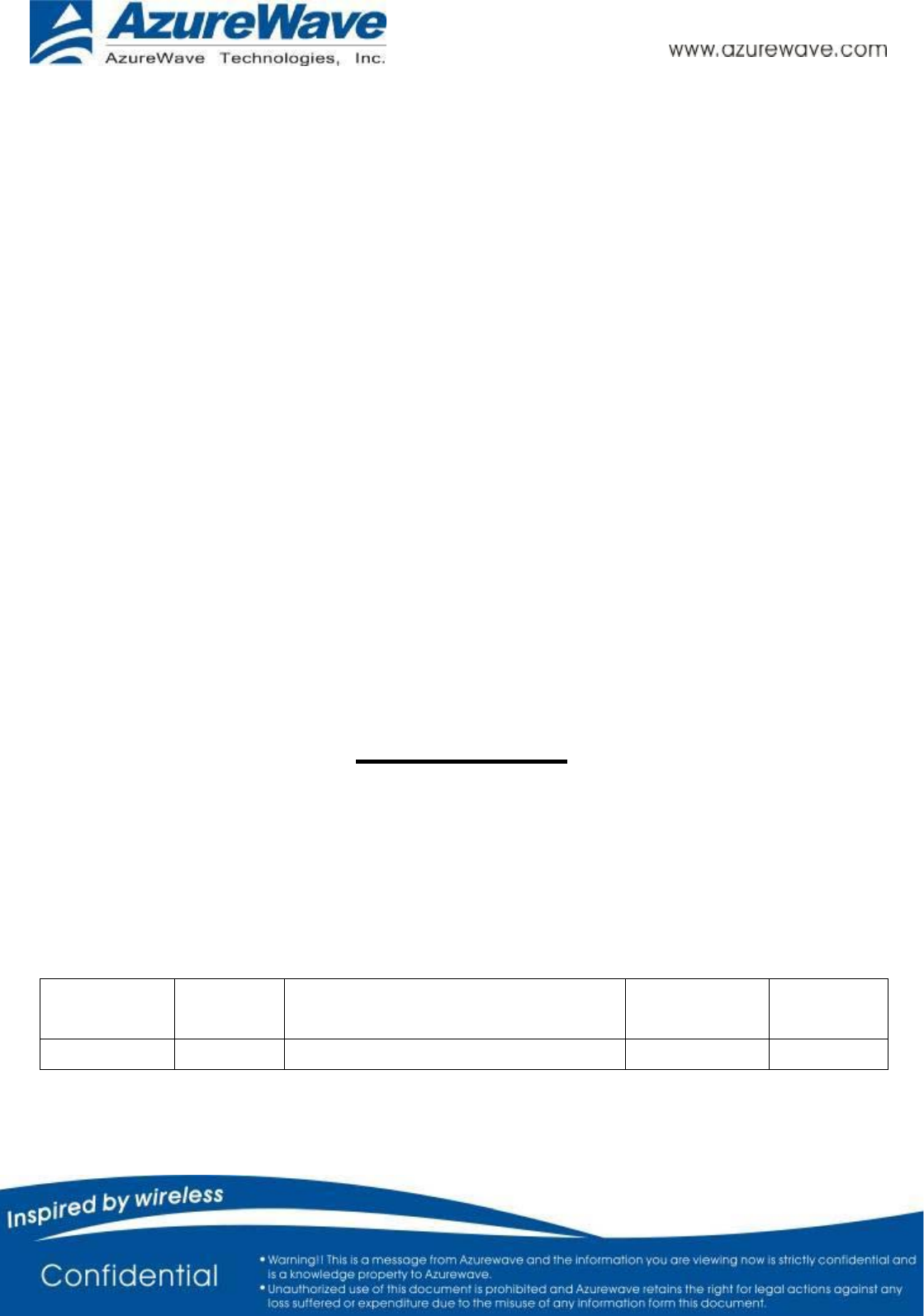
1
AW-NM383
IEEE 802.11 b/g/n Wireless LAN Module
User Guide
Version 0.1
Document
release Date Modification Initials Approved
Ver. 0.1 2013/10/07 Initial version Renton Tao Ivan Chen
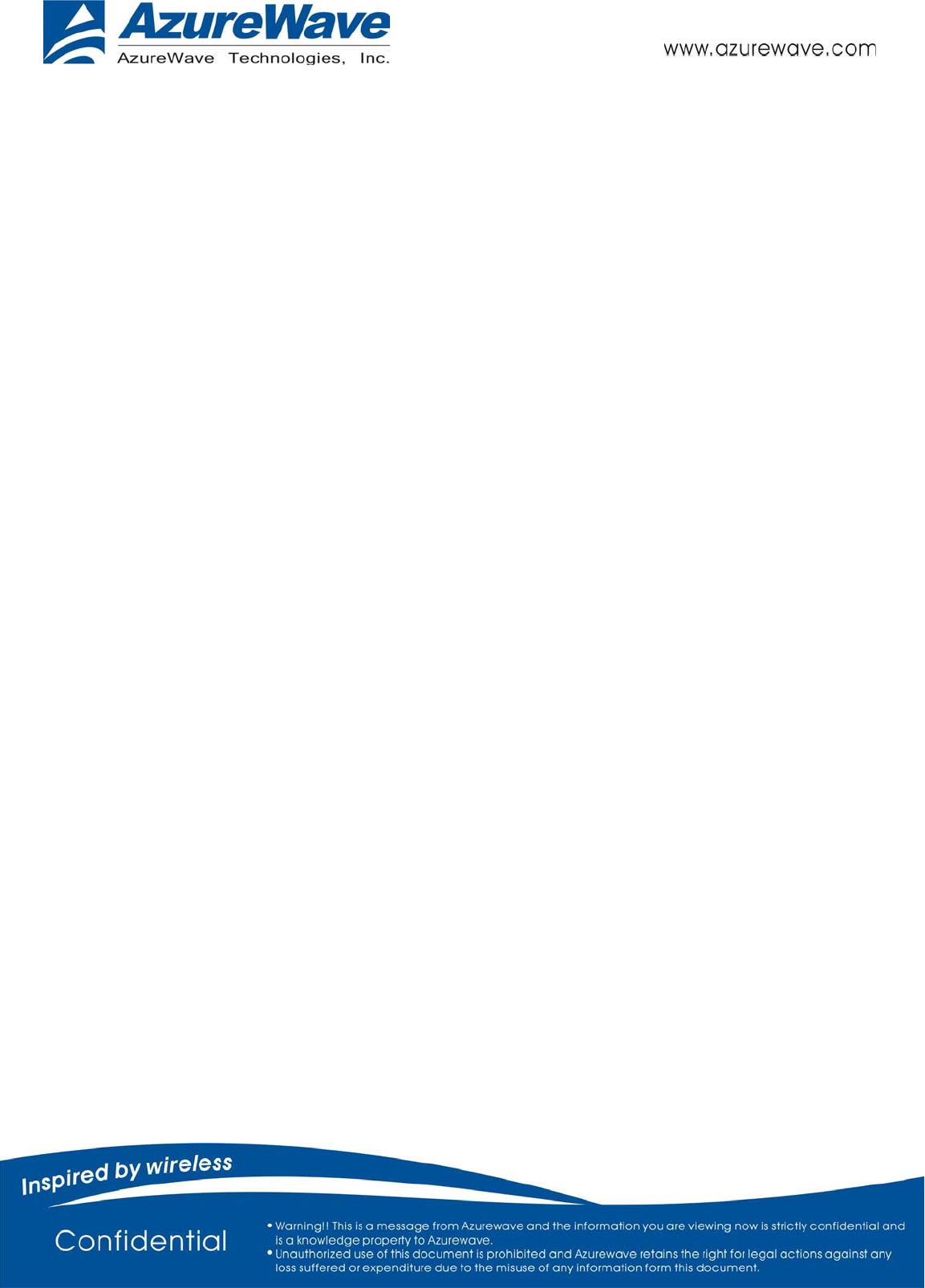
- 3 -
1. General Description
1-1. Product Overview and Functional Description
AzureWave Technologies, Inc. introduces the first IEEE 802.11b/g/n WLAN module Card
-AW-NM383. The module is targeted to mobile devices including Personal Digital Assistants (PDAs),
Netbook, TV, Tablet and Gaming Device which need small package module, low power consumption,
multiple interfaces and OS support. By using AW-NM383, the customers can easily enable the Wi-Fi
embedded applications with the benefits of high design flexibility, short development cycle, and quick
time-to-market.
Compliance with the IEEE 802.11b/g/n standard, the AW-NM383 uses Direct Sequence Spread Spectrum
(DSSS), Orthogonal Frequency Division Multiplexing (OFDM), DBPSK, DQPSK, CCK and QAM
baseband modulation technologies. A high level of integration and full implementation of the power
management functions specified in the IEEE 802.11 standard minimize the system power requirements by
using AW-NM383. In addition to the support of WPA/WPA2 and WEP 64-bit and 128-bit encryption,
the AW-NM383 also supports the IEEE 802.11i security standard through the implementation of
Advanced Encryption Standard (AES)/Counter Mode CBC-MAC Protocol (CCMP), Wired
Equivalent Privacy (WEP) with Temporal Key Integrity Protocol (TKIP), Advanced Encryption
Standard (AES)/Cipher-Based Message Authentication Code (CMAC), and WLAN Authentication and
Privacy Infrastructure (WAPI) security mechanisms.
For the video, voice and multimedia applications the AW-NM383 support 802.11e Quality of Service
(QoS).
The AW-NM383 supports SDIO for WLAN to the host processor.
AW-NM383 is suitable for multiple mobile processors for different applications. With the support
cellular phone co-existence, the AW-NM383 is also the best solution for mobile phones and PDA
phones applications.
AW-NM383 module adopts Marvell’s latest highly-integrated WLAN SoC---88W8782. All the other
components are implemented by all means to reach the mechanical specification required.
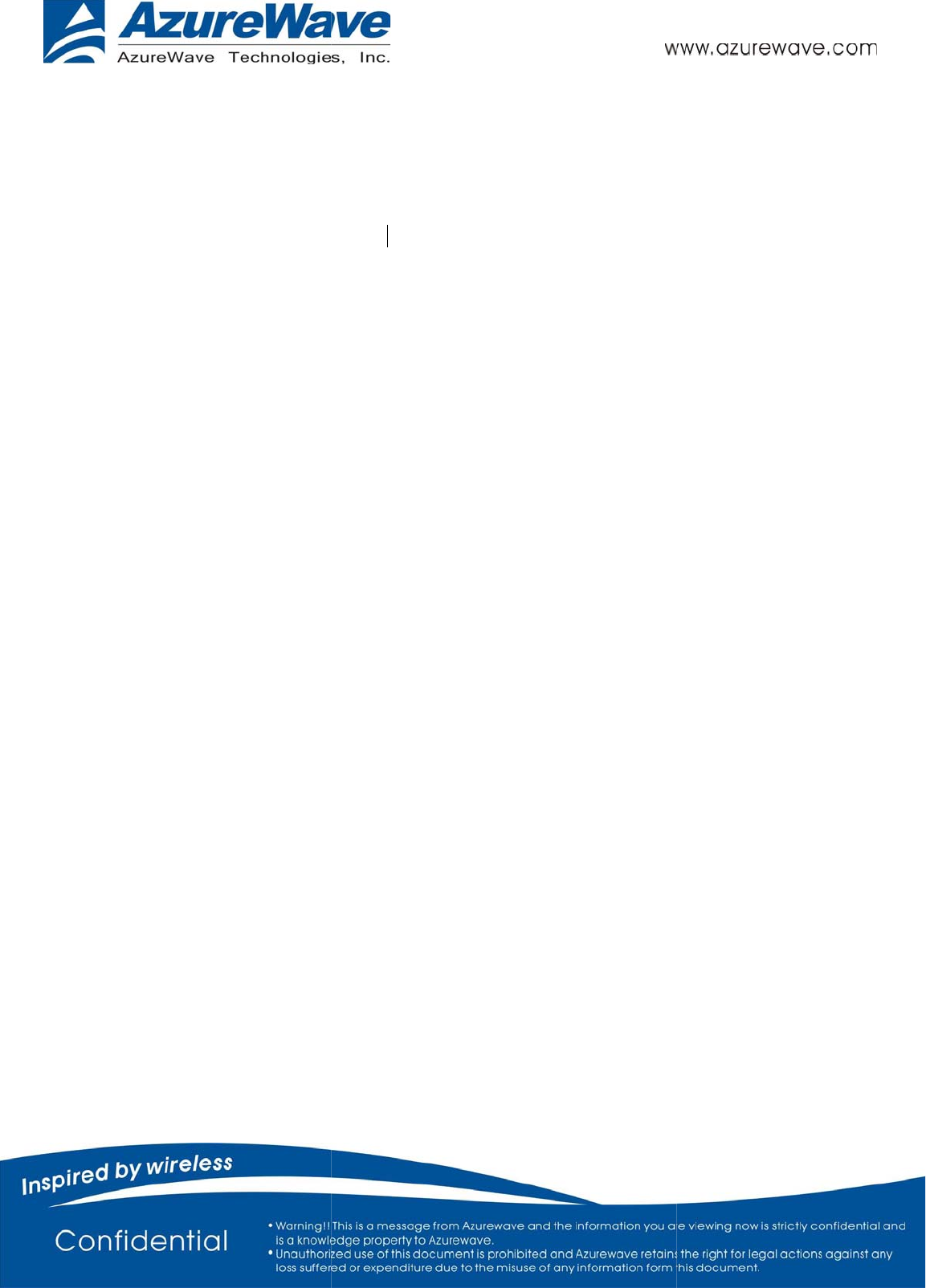
1-2. Key Features
Small footprint: 35mm(L) x
4
SDIO interfaces support for
W
Cellular phone co-existence s
Multiple power saving mode
s
IEEE 802.11i for advanced s
e
Quality of Service (QoS) sup
p
Drip-in WLAN Linux driver
s
Support for Linux kernel ve
r
Support for BlueZ v4.47 Blu
e
Simultaneous AP-STA
Support China WAPI
Lead-free design
1-3. Block Diagram
- 4 -
4
0mm(W) x 5 mm(H)
W
LAN
upport
s
for low power consumption
e
curity
p
ort for multimedia applications
s
are Android ready and validated on And
r
sions up to 2.6.32.
e
tooth profiles stack used in Android Éclai
roid based systems.
r.
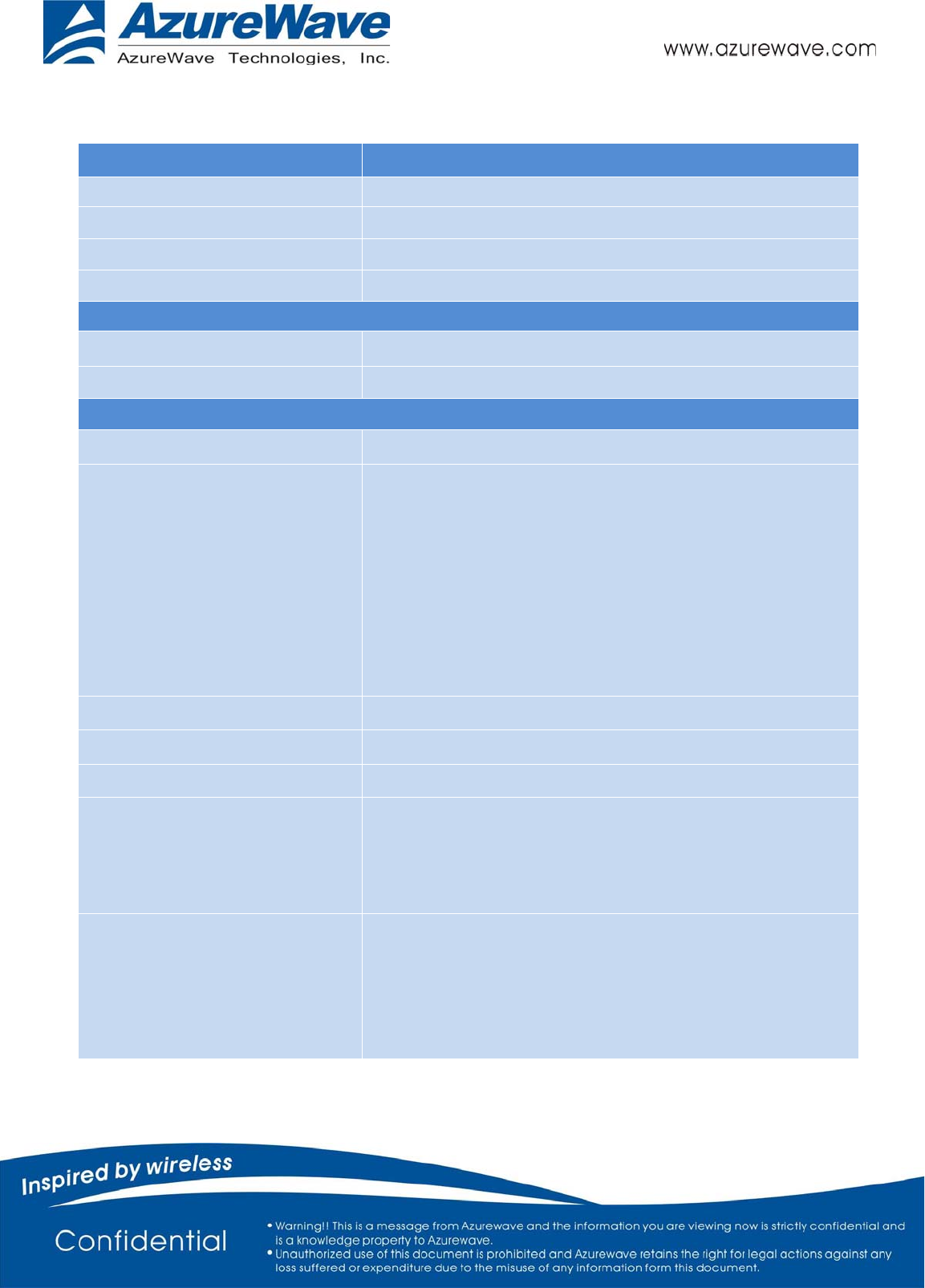
- 5 -
2. Specifications Table
Product Description Wireless LAN Module Card
WLAN Standard IEEE 802.11b/g/n, Wi-Fi compliant
Host Interface SDIO / G-SPI for WLAN
Major Chipset
Marvell 8782
Dimension 40mm x 35mm x 5.0mm
Operating Conditions
Voltage 3.3V +/- 10%, 1.8V +/- 10%
Temperature Operating: -20 ~ 70
o
C ; Storage: -40 ~ 85
o
C
Electrical Specifications
Frequency Range 2.4 GHz ISM radio band
Number of Channels
802.11b: USA, Canada and Taiwan – 11
Most European Countries – 13
France – 4, Japan – 14
802.11g: USA, Canada and Taiwan – 11
Most European Countries – 13
Japan – 13
802.11n(HT20): Channel 1~13(2412~2472)
802.11n(HT40): Channel 3~11(2422~2462)
Modulation DSSS, OFDM, DBPSK, DQPSK, CCK, 16-QAM, 64-QAM for WLAN
Antenna 1 antenna for WLAN
Medium Access Protocol CSMA/CA with ACK
Data Rates
WLAN
802.11b: 1, 2, 5.5, 11Mbps
802.11g: 6, 9, 12, 18, 24, 36, 48, 54Mbps
802.11n MCS0-7 up to 150Mbps
Security
WAPI
WEP 64-bit and 128-bit encryption with H/W TKIP processing
WPA/WPA2 (Wi-Fi Protected Access)
AES-CCMP hardware implementation as part of 802.11i security
standard
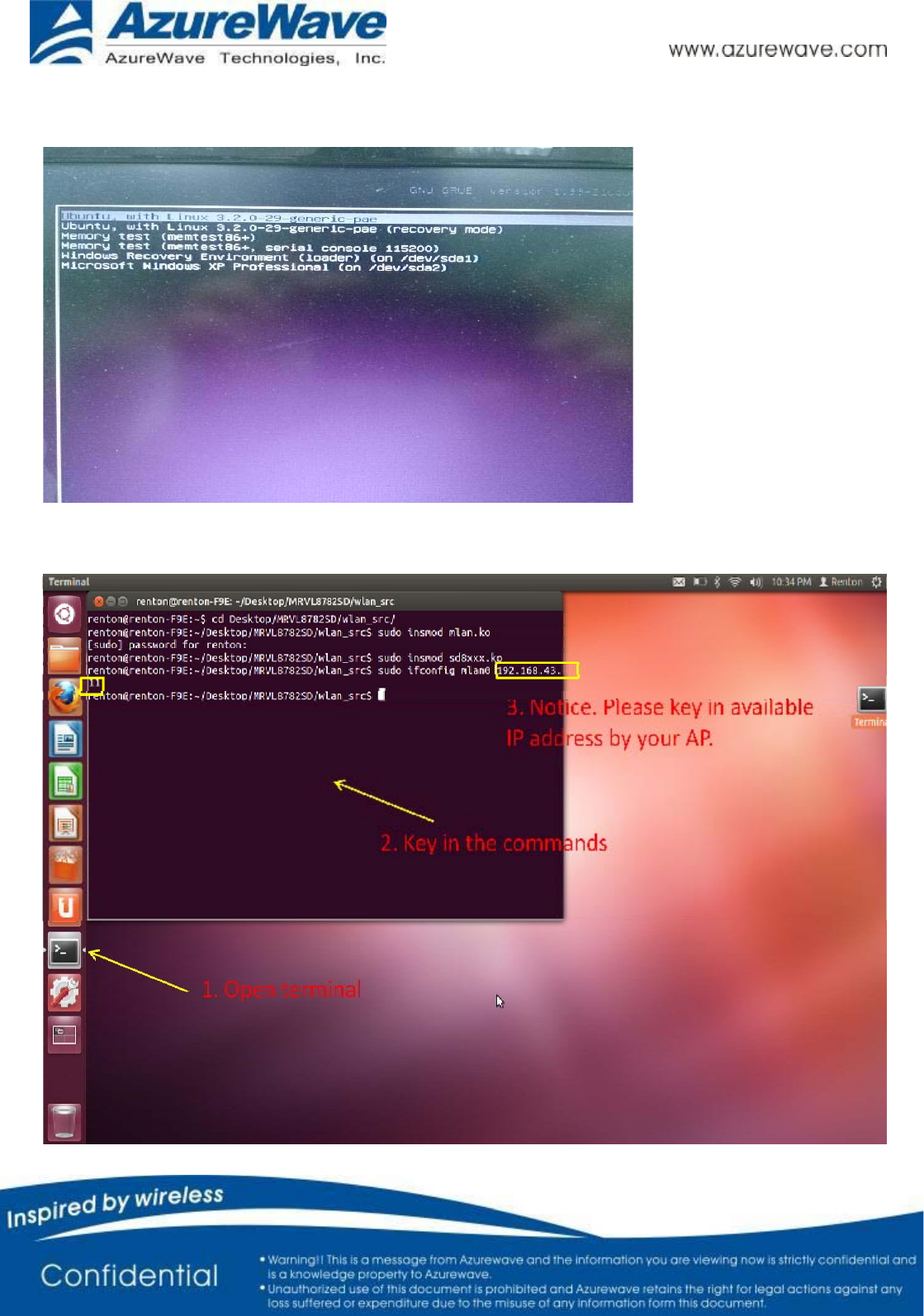
2
Step1: Power on notebook PC and choose Ubuntu OS.
Step2: Plug in USB cable to connect DUT and notebook PC.
Step3: Open terminal and key in commands. Password is “000000”.
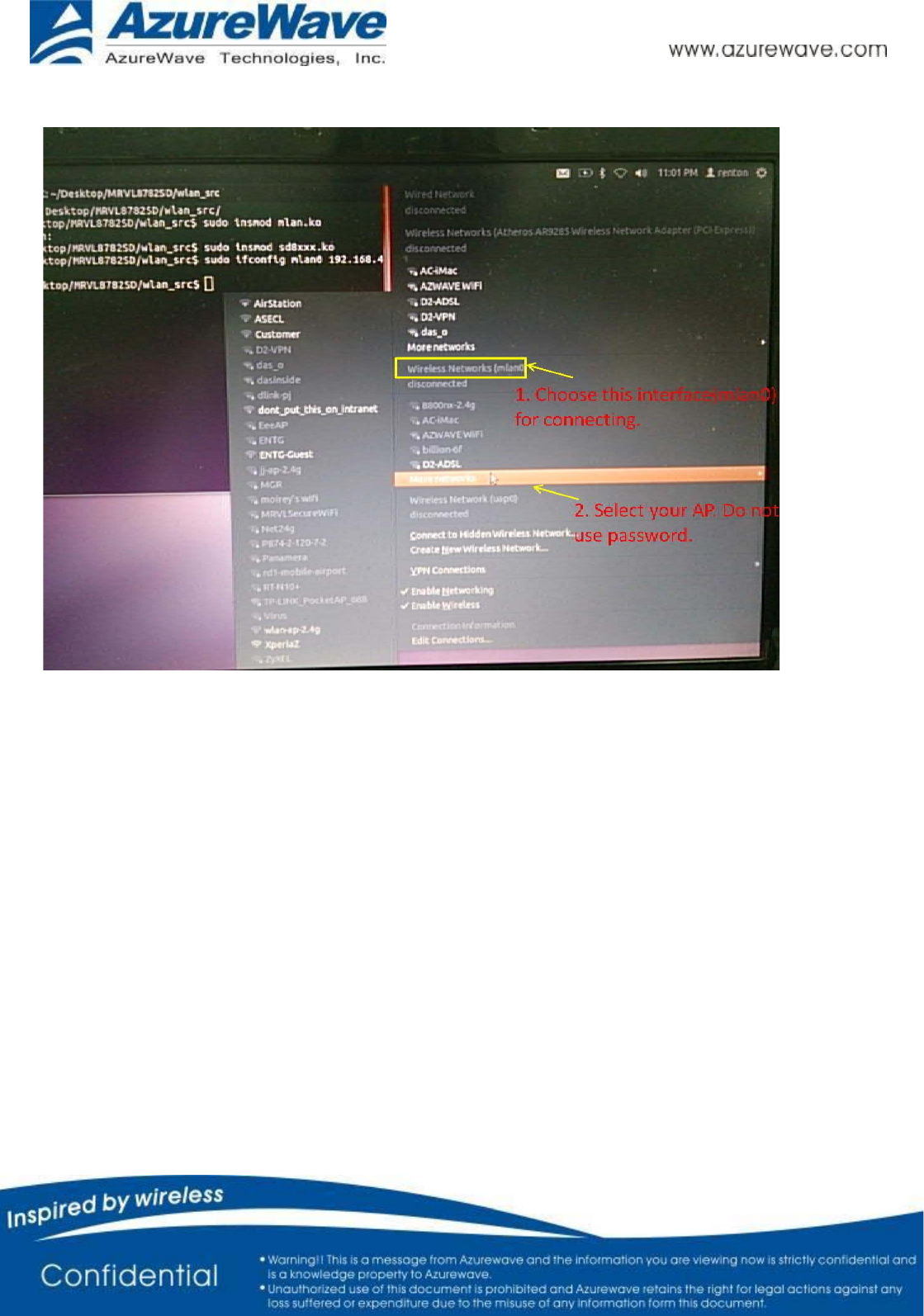
3
Step4: Select below interface and connect to your AP.
You can do further RF set up by using command “iwconfig”.
Ex. sudo iwconfig –h.
You can see how to set up by different commands.
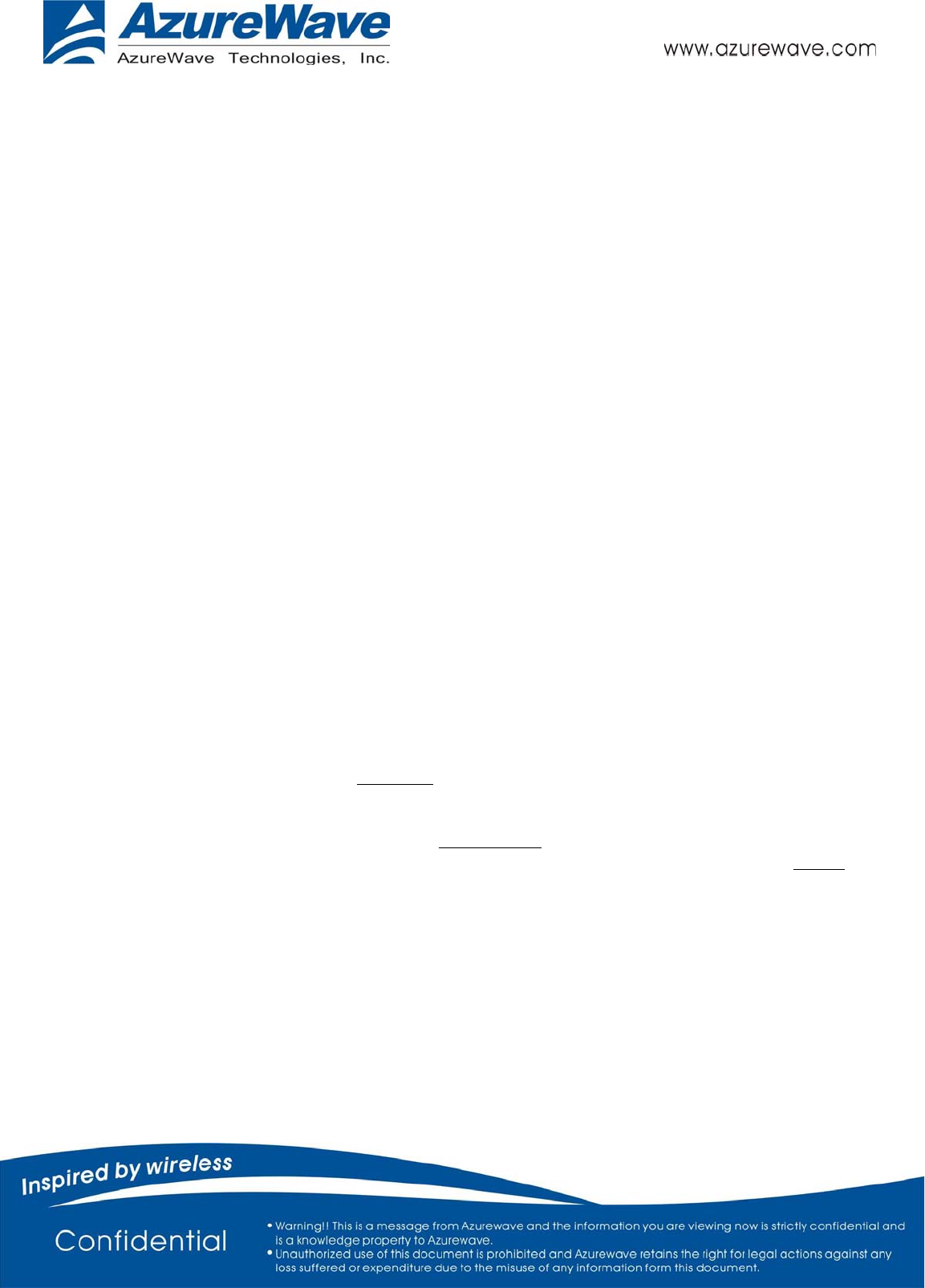
- 12 -
2-4. SDIO Host Interface Specifications
Referred from Marvell hardware specifications
SDIO Protocol Timing Diagram
SDIO Protocol Timing Diagram—High Speed Mode
Federal Communication Commission Interference Statement
This device complies with Part 15 of the FCC Rules. Operation is subject to the following two conditions: (1) This device may
not cause harmful interference, and (2) this device must accept any interference received, including interference that may
cause undesired operation.
This equipment has been tested and found to comply with the limits for a Class B digital device, pursuant to Part 15 of the
FCC Rules. These limits are designed to provide reasonable protection against harmful interference in a residential
installation. This equipment generates, uses and can radiate radio frequency energy and, if not installed and used in accordance
with the instructions, may cause harmful interference to radio communications. However, there is no guarantee tha
t
interference will not occur in a particular installation. If this equipment does cause harmful interference to radio or television
reception, which can be determined by turning the equipment off and on, the user is encouraged to try to correct the
interference by one of the following measures:
- Reorient or relocate the receiving antenna.
- Increase the separation between the equipment and receiver.
- Connect the equipment into an outlet on a circuit different from that
to which the receiver is connected.
- Consult the dealer or an experienced radio/TV technician for help.
FCC Caution: Any changes or modifications not expressly approved by the party responsible for compliance could void the
user's authority to operate this equipment.
This transmitter must not be co-located or operating in conjunction with any other antenna or transmitter.
Radiation Exposure Statement:
This equipment complies with FCC radiation exposure limits set forth for an uncontrolled environment. This equipmen
t
should be installed and operated with minimum distance 20cm between the radiator & your body.
This device is intended only for OEM integrators under the following conditions:
1) The antenna must be installed such that 20 cm is maintained between the antenna and users, and
2) The transmitter module may not be co-located with any other transmitter or antenna.
As long as 2 conditions above are met, further transmitter test will not be required. However, the OEM integrator is still
responsible for testing their end-product for any additional compliance requirements required with this module installed
IMPORTANT NOTE: In the event that these conditions can not be met (for example certain laptop configurations or co-
location with another transmitter), then the FCC authorization is no longer considered valid and the FCC ID can not be used on
the final product. In these circumstances, the OEM integrator will be responsible for re-evaluating the end product (including
the transmitter) and obtaining a separate FCC authorization.
End Product Labeling
This transmitter module is authorized only for use in device where the antenna may be installed such that 20 cm may be
maintained between the antenna and users. The final end product must be labeled in a visible area with the following:
“Contains FCC ID: TLZ-NM383”. The grantee's FCC ID can be used only when all FCC compliance requirements are met.
Manual Information To the End User
The OEM integrator has to be aware not to provide information to the end user regarding how to install or remove this RF
module in the user's manual of the end product which integrates this module.
The end user manual shall include all required regulatory information/warning as show in this manual.
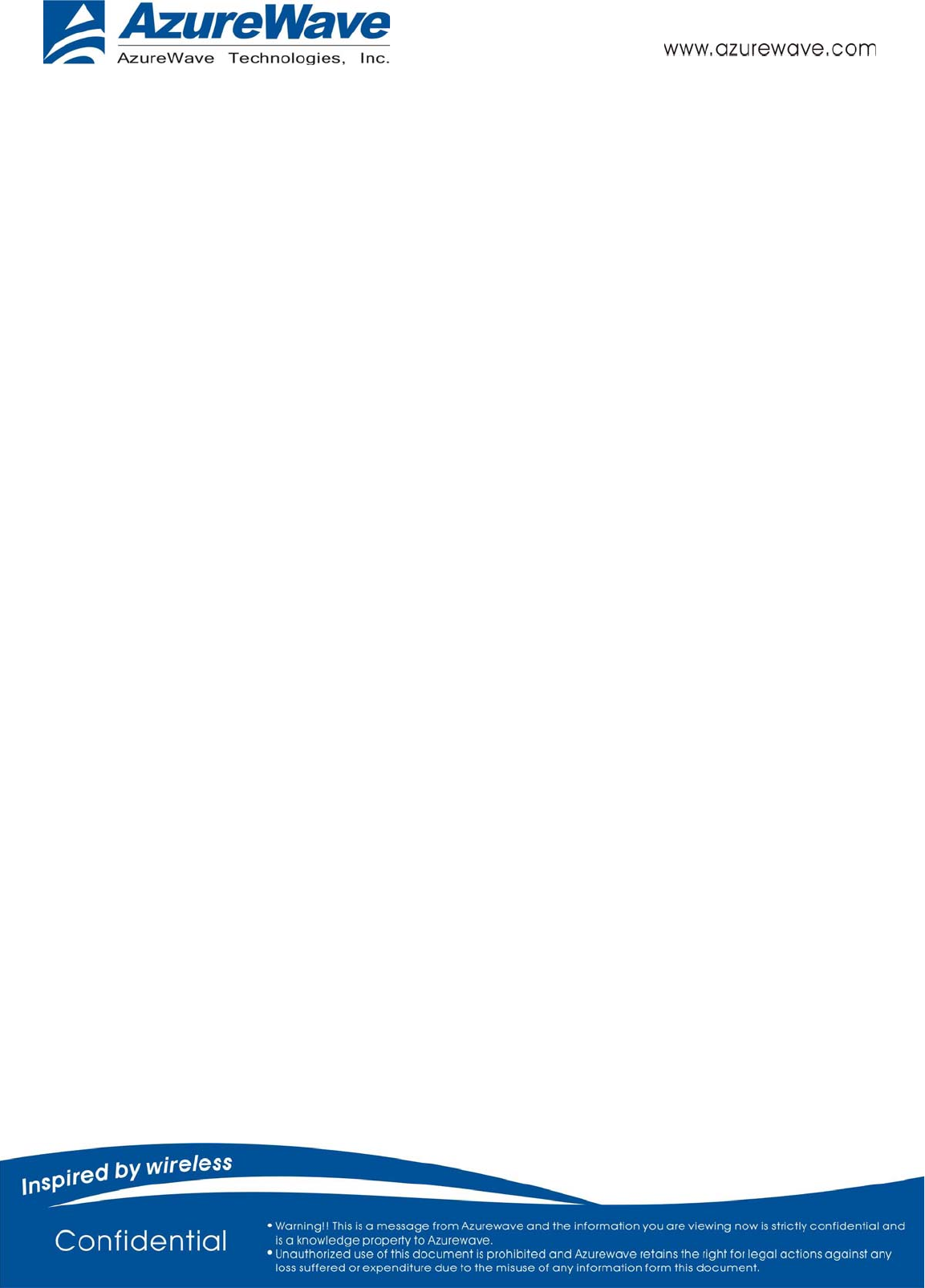
- 13 -
3. Dimension:
TBC
4. Pin Definition
Pin Assignment
Pin No Definition Basic Description Type
1 PDn
)XOO3RZHU'RZQDFWLYHORZ
IXOOSRZHUGRZQPRGH
QRUPDOPRGH
Connect to power down pin of host or 1.8V
External host required to drive this pin high for normal operation
No internal pull-up on this pin
I
2 VIO +3.3V power supply P
3 GND
4 SD_CLK
SDIO 4-bit Mode: Clock Input
SDIO 1-bit Mode: Clock Input
SDIO SPI Mode: Clock Input
I
5 GND
6 SD_D3
SDIO 4-bit Mode: Data line bit[3]
SDIO 1-bit Mode: Reserved
SDIO SPI Mode: Card Select(active low)
I/O
7 SD_D2
SDIO4-bit Mode: Data line bit[2]or Read Wait(optional)
SDIO 1-bit Mode: Read Wait(optional)
SDIO SPI Mode: Reserved
I/O
8 SD_D1
SDIO 4-bit Mode: Data line bit[1]
SDIO 1-bit Mode: Interrupt
SDIO SPI Mode: Reserved
I/O
9 SD_D0
SDIO 4-bit Mode: Data line bit[0]
SDIO 1-bit Mode: Data line
SDIO SPI Mode: Data output
I/O
10 SD_CMD
SDIO 4-bit Mode: Command/Response
SDIO 1-bit Mode: Command Line
SDIO SPI Mode: Data Input
I
11 GND
12 VCC +3.3V power supply P
13 GPIO[2] Host Wakeup: SoC-to-Host Wakeup (output) O
5. Mechanical Characteristic
5.1
TBC
Industry Canada statement:
This device complies with RSS-210 of the Industry Canada Rules. Operation is subject to the following two conditions: (1)
This device may not cause harmful interference, and (2) this device must accept any interference received, including
interference that may cause undesired operation.
Ce dispositif est conforme à la norme CNR-210 d'Industrie Canada applicable aux appareils radio exempts de licence. Son
fonctionnement est sujet aux deux conditions suivantes: (1) le dispositif ne doit pas produire de brouillage préjudiciable, et
(2) ce dispositif doit accepter tout brouillage reçu, y compris un brouillage susceptible de provoquer un fonctionnement
indésirable.
Radiation Exposure Statement:
This equipment complies with IC radiation exposure limits set forth for an uncontrolled environment. This equipment shoul
d
b
e installed and operated with minimum distance 20cm between the radiator & your body.
Déclaration d'exposition aux radiations:
Cet équipement est conforme aux limites d'exposition aux rayonnements IC établies pour un environnement non contrôlé.
Cet équipement doit être installé et utilisé avec un minimum de 20 cm de distance entre la source de rayonnement et votre
corps.
This device is intended only for OEM integrators under the following conditions: (For module device use)
1) The antenna must be installed such that 20 cm is maintained between the antenna and users, and
2) The transmitter module may not be co-located with any other transmitter or antenna.
As long as 2 conditions above are met, further transmitter test will not be required. However, the OEM integrator is still
responsible for testing their end-product for any additional compliance requirements required with this module installed.
Cet appareil est conçu uniquement pour les intégrateurs OEM dans les conditions suivantes: (Pour utilisation de
dispositif module)
1) L'antenne doit être installée de telle sorte qu'une distance de 20 cm est respectée entre l'antenne et les utilisateurs, et
2) Le module émetteur peut ne pas être coïmplanté avec un autre émetteur ou antenne.
Tant que les 2 conditions ci-dessus sont remplies, des essais supplémentaires sur l'émetteur ne seront pas nécessaires.
Toutefois, l'intégrateur OEM est toujours responsable des essais sur son produit final pour toutes exigences de conformité
supplémentaires requis pour ce module installé.
IMPORTANT NOTE:
In the event that these conditions can not be met (for example certain laptop configurations or co-location with anothe
r
transmitter), then the Canada authorization is no longer considered valid and the IC ID can not be used on the final product.
In these circumstances, the OEM integrator will be responsible for re-evaluating the end product (including the transmitter)
and obtaining a separate Canada authorization.
NOTE IMPORTANTE:
Dans le cas où ces conditions ne peuvent être satisfaites (par exemple pour certaines configurations d'ordinateur portable ou
de certaines co-localisation avec un autre émetteur), l'autorisation du Canada n'est plus considéré comme valide et l'ID IC ne
p
eut pas être utilisé sur le produit final. Dans ces circonstances, l'intégrateur OEM sera chargé de réévaluer le produit final
(y compris l'émetteur) et l'obtention d'une autorisation distincte au Canada.
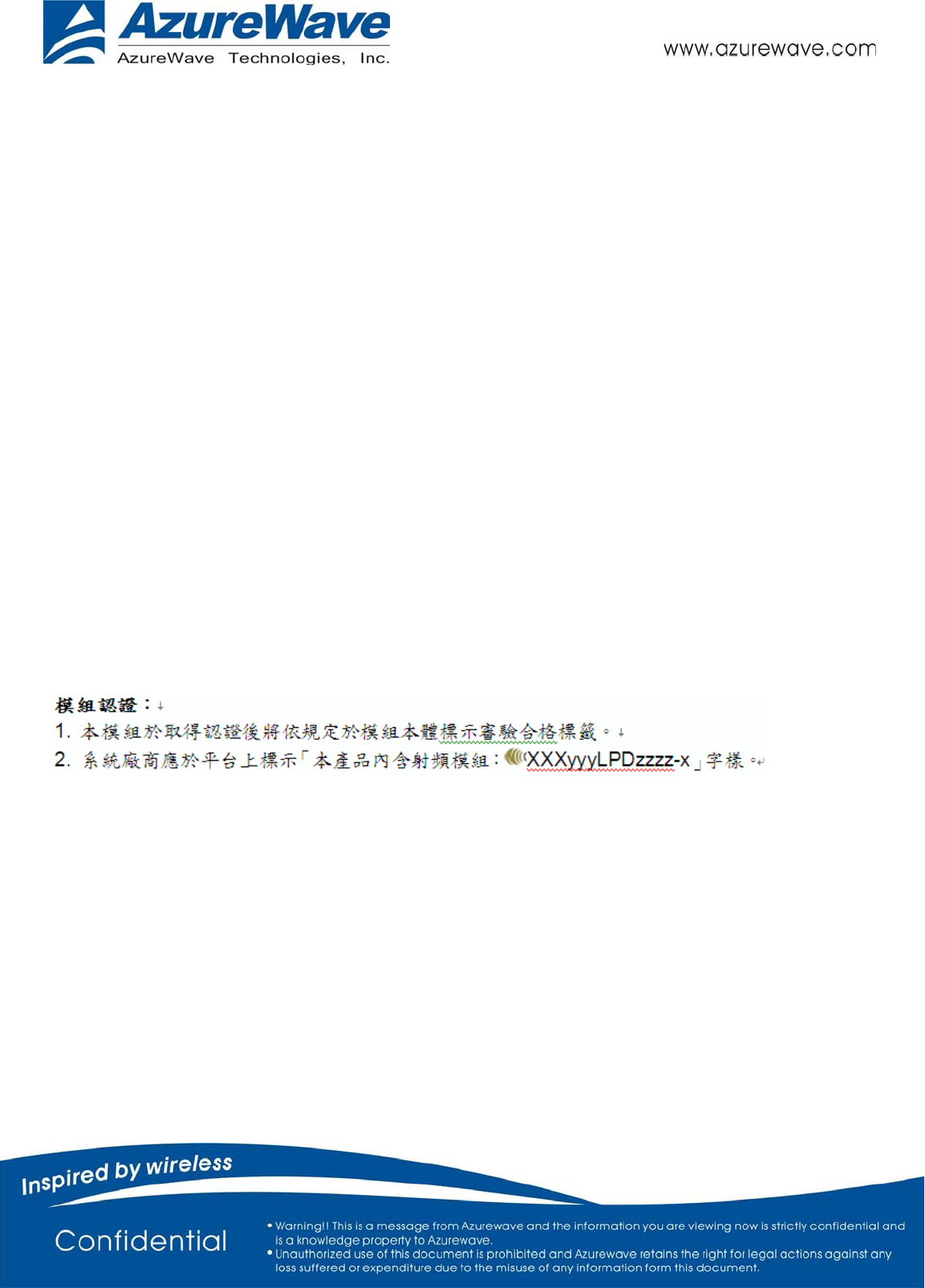
- 14 -
End Product Labeling
This transmitter module is authorized only for use in device where the antenna may be installed such that 20 cm may be
maintained between the antenna and users. The final end product must be labeled in a visible area with the following:
“Contains IC: 6100A-NM383”.
Plaque signalétique du produit final
Ce module émetteur est autorisé uniquement pour une utilisation dans un dispositif où l'antenne peut être installée de
telle sorte qu'une distance de 20cm peut être maintenue entre l'antenne et les utilisateurs. Le produit final doit être
étiqueté dans un endroit visible avec l'inscription suivante: "Contient des IC: 6100A-NM383".
Manual Information To the End User
The OEM integrator has to be aware not to provide information to the end user regarding how to install or remove this
RF module in the user's manual of the end product which integrates this module.
The end user manual shall include all required regulatory information/warning as show in this manual.
Manuel d'information à l'utilisateur final
L'intégrateur OEM doit être conscient de ne pas fournir des informations à l'utilisateur final quant à la façon d'installe
r
ou de supprimer ce module RF dans le manuel de l'utilisateur du produit final qui intègre ce module.
Le manuel de l'utilisateur final doit inclure toutes les informations réglementaires requises et avertissements comme
indiquͼ dans ce manuel.
եфႝݢᒟ܄ႝᐒᆅᒤݤ!
ಃΜΒచ ࠠԄᇡӝϐեфᓎႝᐒǴߚёǴϦљǵဦ܈٬Ҕޣ֡όளᏰԾᡂ׳ᓎǵуεф
܈ᡂ׳চीϐ܄ϷфૈǶ!
ಃΜѤచ եфᓎႝᐒϐ٬Ҕόளቹៜ०ૐӼӄϷυᘋӝݤ೯ߞǹวԖυᘋຝਔǴᔈҥջଶҔǴ٠ׯ
๓ԿคυᘋਔБளᝩុ٬ҔǶ!
ӝݤ೯ߞǴࡰ٩ႝߞݤೕۓբϐคጕႝ೯ߞǶ!
եфᓎႝᐒהڙӝݤ೯ߞ܈πǵࣽᏢϷᙴᕍҔႝݢᒟ܄ႝᐒഢϐυᘋǶ!